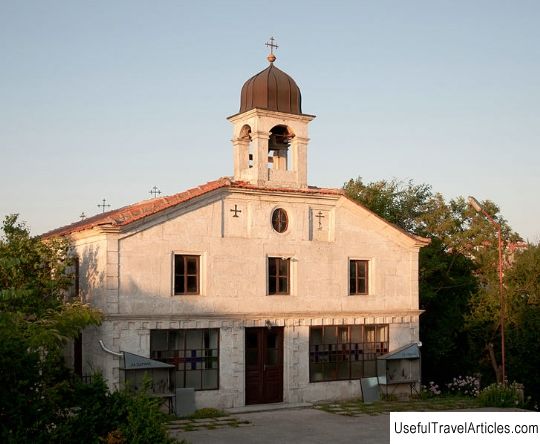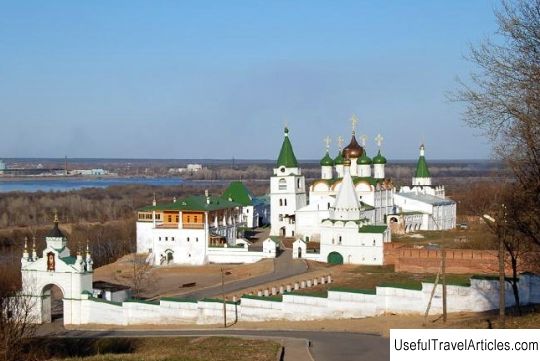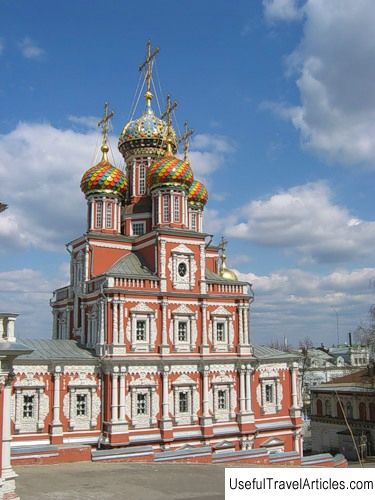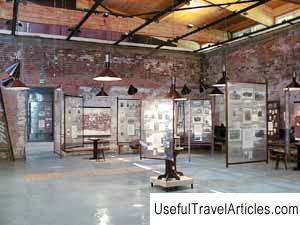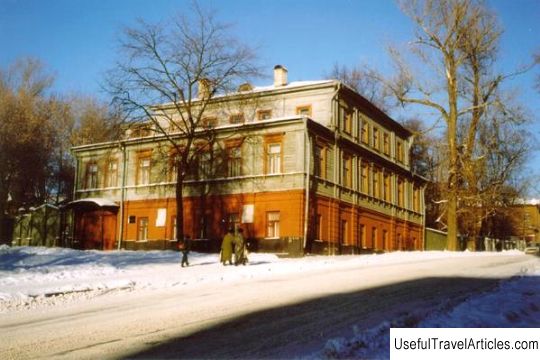Nizhny Novgorod Kremlin description and photos - Russia - Volga region: Nizhny Novgorod
Rating: 9,4/10 (7904 votes) 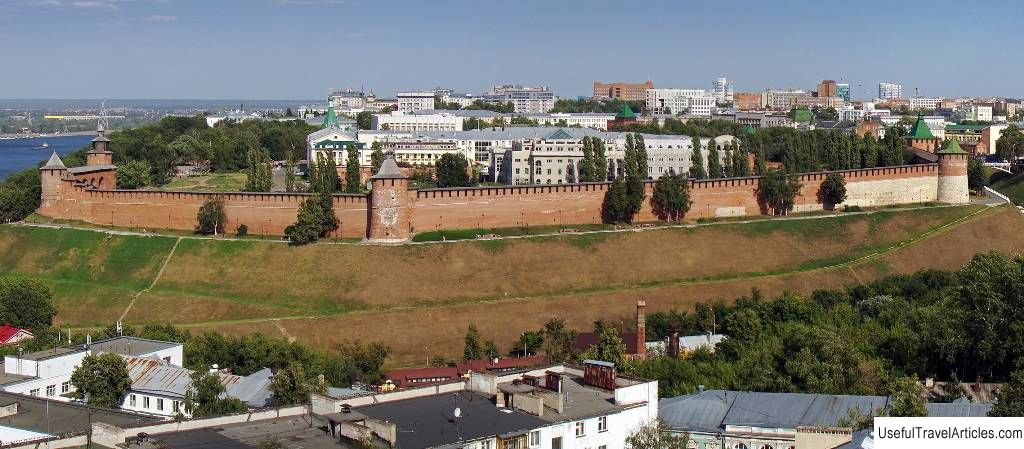
Nizhny Novgorod Kremlin description and photos - Russia - Volga region: Nizhny Novgorod. Detailed information about the attraction. Description, photos and a map showing the nearest significant objects. Photo and descriptionOn a high bank above the confluence of two great rivers - the Oka and the Volga - there is a picturesque Nizhny Novgorod Kremlin. He stands on a high cliff. The large height difference between different sections of its walls and towers makes it unusual. The Kremlin houses a 17th-century tent-roofed cathedral, museum exhibitions and monuments, and offers a magnificent view of the city and the river space. History of the fortressNizhny Novgorod was founded in 1221 by the Vladimir prince Yuri Vsevolodovich. It was a wooden fortress at the confluence of the Oka and Volga, which defended the southern border of the Vladimir principality. Almost immediately, the new fortress had to defend itself - the surrounding Mordovian tribes tried several times to destroy it, and when the Tatar-Mongol invasion began, the Mordovian tribes were divided and some of them came out on the Mongol side. The stone Kremlin begins to be built here at the very beginning of the 16th century - now Nizhny Novgorod opposed the Kazan Khanate. It began to be built in 1500 and finished in 1516. During this time, the fortress under construction managed to repel the Tatar raid, and the old wooden Kremlin finally burned down. The new fortress was built by Italian craftsmen under the leadership of Peter Fryazin or otherwise Pietro Francesco. Therefore, the Nizhny Novgorod Kremlin is so similar to the Moscow one - it was built in the same Western European tradition, there are similar battlements and several similar fortifications. The Nizhny Novgorod Kremlin was built exceptionally well and strong - it is one of the few Russian fortresses that the enemies never managed to capture. The fortress had 13 towers, and one of them is a drainage with a bridge. On both sides, the Kremlin was surrounded by rivers, and on the third it was protected by a huge ditch thirty meters wide. Scientists argue whether it was dry or flooded with groundwater. Nizhny Novgorod played a decisive role in the Time of Troubles. The famous K. Minin was the zemstvo headman in Nizhny Novgorod and kept a butcher's shop here. It was he, together with Prince D. Pozharsky, who became the organizer of the people's militia in the city. Now in memory of this, a monument to Minin and Pozharsky stands near the walls of the Nizhny Novgorod Kremlin - the same as in Moscow, only a little smaller. Already at the end of the 17th century, the Nizhny Novgorod fortress lost its significance. But, unlike many other kremlin, it was not dismantled, but, on the contrary, was repaired. The roof was removed from the walls, protecting the battle passages, and the battlements were shortened, and in the middle of the 19th century, when the city was rebuilt according to a new plan, the moat around the Kremlin was filled up. The Kremlin itself was plastered, and it became snow-white. As a result of the reconstruction, the walls became lower, and their foundations began to be periodically heated. By the end of the 19th century, the Kremlin was badly dilapidated. But at the end of the century, in the wake of interest in history, he was again put in order. One of the towers was restored as a museum, the rest was whitewashed, and a funicular was built to the Kremlin itself from the embankment, which worked until 1926, when a tram line passed next to the fortress. Kremlin in the XX century In the Soviet years, part of the Kremlin was nearly demolished. There was a project to expand the Soviet Square (that was the name of Minin and Pozharsky Square). Soviet Square was supposed to continue until the House of Soviets. A monument to Sverdlov was to be erected on the site of the Dmitrovsky tower. But the plans did not come true - the war began. The fortress again took part in hostilities: anti-aircraft guns were installed on several towers to defend the city from German attacks, and the Gorky division went to the front from the walls of the Kremlin. Two monuments on the territory of the Kremlin remind of these events. Eternal Flame, in honor of all who died in that war and the exhibition "Gorky - to the front!" near the Dmitrovsky tower, dedicated to the labor feat of the city residents. This is an exhibition of military equipment and commemorative plaques with the names of military units formed in Gorky. After the war, a large-scale restoration began in the Kremlin under the leadership of the architect Svyatoslav Agafonov. He was one of the leading Soviet experts on northern fortresses, he advised on the restoration of Smolensk and Pskov. Settled walls, Borisoglebskaya tower, buildings inside the Kremlin were restored. The new restoration was carried out at the beginning of the XXI century. Walls and towers All 13 towers of the Kremlin have been preserved. The length of the walls is more than 2 kilometers, the height together with the battlements is up to 12 meters (and earlier they were 4 meters higher!). You can walk along one of the sections. The most famous of the towers is Dmitrovskaya. She is the main gateway to the Kremlin and one of the symbols of the city - it is she who can most often be seen on souvenir products. Once it had a specific fortification, which is called the "outlet tower", the same as the Kutafya tower of the Moscow Kremlin. An arched bridge connected the Dmitrovskaya with a pentagonal draw-off tower, and both towers were surrounded by a dry moat. According to some opinions, the bridge was liftable. It was on these towers that more than half of the entire Nizhny Novgorod artillery was concentrated. There were several copper squeaks that fired cannonballs. By the 19th century, the tower had changed a lot: the moat was filled up, additional fortifications were dismantled. It housed the garrison, and then the provincial archive. At the end of the 19th century, the idea of placing a museum exhibition in it appeared. The tower was restored according to the project of N. Sultanov, taking as a model one of the ancient towers of the Novgorod Kremlin. Now the Dmitrov Tower is still part of the museum - the exposition of the department of nature is located here. The Nikolskaya Tower is named after the Nikolskaya Church that once stood opposite. This temple has not survived, but a memorial chapel now stands in its place. The Nikolskaya Tower is used by the museum for temporary exhibitions. The Conception Tower was restored quite recently - in 2012. It was a passage tower, otherwise it was called "White" - it is believed that it was the only one faced with white stone. Now it is decorated with light decor in memory of this, and it also houses museum exhibitions: a small archaeological collection, and a hall dedicated to the militia of 1612, and an observation deck with a telescope is set up above. The Archangel Michael Cathedral The first wooden cathedral in the name of the Archangel Michael stood here since the founding of the city - it was founded simultaneously with the fortress. The tent building of the temple, which has come down to us, was erected in 1631. The temple was rebuilt several times. In Soviet times, this church remained the only one on the territory of the Kremlin - all the rest were demolished, but it was also closed in 1928. An archive is located within its walls. In 1962, the ashes of Kozma Minin were brought here. At the same time, restoration followed, which returned the appearance of the temple to its original - such as it was in the middle of the 17th century. In the early 1990s, the cathedral was handed over to the Church, and a monument to the founders of the city was erected in front of it in 2008: Bishop Simon of Suzdal and Prince Yuri Vsevolodovich, son of Vsevolod the Big Nest. Artistic museumIn 1841, the building of the residence of the military governor in the classicism style was built in the Kremlin. Now it houses an exposition of an art museum dedicated to Russian art of the 17th-20th centuries. It contains a large collection of icon painting from pre-revolutionary merchant collections, many works of outstanding painters of the 18th-19th centuries: F. Rokotov, A.G. Venetsianov, K. Bryullov, I. Aivazovsky, whole large collections of paintings by Y. Kustodiev and N. Roerich. There are sections with open funds - for example, a separate room is dedicated to silver items of the 15th-20th centuries. Other Kremlin buildings and lost churches Once upon a time there were three more churches in the Kremlin, besides the Archangel Michael Cathedral. The Great Spaso-Preobrazhensky Cathedral was once built on the model of the Moscow Uspensky Cathedral. In 1929 it was blown up, and the House of Soviets was built in its place. This is an interesting construction in the style of constructivism designed by architect A. Grinberg; now it houses the city council and the administration. A veneration cross is erected nearby in memory of the lost cathedral. Opposite the Spaso-Preobrazhensky Cathedral was the Assumption Cathedral, erected in memory of the people of Nizhny Novgorod who fell in the war of 1812. Most of the funds for it were allocated by the landowner Maria Mertvago, whose husband died. The temple received the status of "military", garrison. It was demolished after the revolution, and in its place is now the building of the presidential residence. In addition, in 2012, the Spasskaya chapel was erected in memory of the cathedral. There was also a third church - St. Simeon the Stylite. Already in our time, excavations were carried out at this place and found not only the foundation of the temple itself, but also the remains of a settlement and burials of the 13th century. The restoration of this church is now planned.           We also recommend reading The A. S. Popova description and photo - Russia - St. Petersburg: Kronstadt Topic: Nizhny Novgorod Kremlin description and photos - Russia - Volga region: Nizhny Novgorod. |
